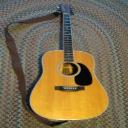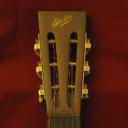Yahoo Answers is shutting down on May 4th, 2021 (Eastern Time) and beginning April 20th, 2021 (Eastern Time) the Yahoo Answers website will be in read-only mode. There will be no changes to other Yahoo properties or services, or your Yahoo account. You can find more information about the Yahoo Answers shutdown and how to download your data on this help page.
Trending News
What effect does an ebony top have on the tone of a mahogany bodied electric guitar?
Not sure if anyone will be able to help me with this, but I figured I'd ask anyway.
I've been doing some research into the tonal characteristics of various woods used in electric guitar construction. I know everything I need to know about the more common woods and combinations of woods.
However, I acquired a guitar that has a very unusual wood combination. It has a 5 piece maple/mahogany neck, an ebony fretboard, and a mahogany body. Fairly common combination of woods, right? Here's where the curveball comes in: It has an ebony top over the mahogany body.
Nothing in any of the research I have done even hints that it had ever been done. Ebony is not on the radar anywhere as far as being used for guitar bodies or tops. It is only ever mentioned as a fretboard material. Until I got the guitar I have now (LTD F-2E), I didn't realize anyone had done it before either.
So, any guitar connoisseurs out there have any idea what properties an ebony top confers to the tone of an electric guitar? I know what my guitar sounds like, I just want to know what part of the tone is being provided by which wood.
And don't tell me the wood an electric guitar is made of makes no difference. If that were true, a Stratocaster and a Les Paul with the same pickups installed would sound exactly the same, and they don't. They are made of different woods. (Ash and mahogany, respectively)
Thanks in advance!
This is the guitar in question: http://www.zzounds.com/item--ESPF2E
The ebony top is more than just a veneer. Unless of course, you consider a half-inch thick piece of wood to be a veneer.
Ash Stratocasters and Alder Stratocasters don't sound identical. Similar, but not exactly the same. The rare mahogany Strat sounds even more different.
Agathis, poplar, and Alder Jacksons don't sound identical either. Again, they are similar but not exactly the same.
Also, if the wood had no effect on the tone of a guitar, why wouldn't guitar companies just use the cheapest wood available for any guitar that appearance is not a factor for? (Such as guitars with solid finishes where the wood grain is not visible)
This question is probably going to end up being a waste of my time, to be honest. Most people who answer either won't have any useful information, or they will try to tell me that the ebony top on my guitar doesn't make any difference at all.
I played this guitar as well before I bought the one I have now: http://www.musiciansfriend.com/guitars/esp-ltd-f-2...
They are both neck-thru guitars, and they have the exact same pickups. They
7 Answers
- TommymcLv 78 years agoFavorite Answer
I think you'll find that the ebony top is just a thin layer on top of the mahogany, and won't have any effect on the tone. It's basically veneer. While the species of wood has some minimal effect on tone, a mahogany body with a thin top layer of ebony is still going to sound like mahogany.
I would argue that there are other factors that have a much greater effect on tone than the wood species. The density of the wood has more of an effect on sustain than tone. Your Strat vs LP "proof" is not a valid argument because you haven't controlled for other differences. Apples vs oranges.....There are a lot of other differences between a LP and Strat, so simply equipping them both with identical pickups proves nothing. The shape and thickness of the bodies, the scale length, hard-tail vs tremolo bridge, circuitry....all of these affect the tone. To truly test the effect wood species has on tone, you'd need to compare guitars that are identical...like an ash LP and a mahogany LP.
No matter how much influence you believe the wood species has, the guitar you've described is basically a mahogany body with a decorative ebony top. There just isn't enough ebony to matter.
********************************************************************************************
Response to Additional Details:
So looking at your example of Ash vs Alder Strats, they are "Similar, but not exactly the same" My point is that the wood species has little enough effect on "tone" to begin with. That means a total ebony body would only sound a little different than a totally mahogany body. Even if the ebony layer is 1/2" thick, it's still only a third of the thickness. If the difference is small to begin with, divide that by a third, and the difference is going to be negligible.
Remember: the pickups are electromagnetic. The vibrating strings interrupt a magnetic field generating a small current that the amplifier boosts. The primary impact of the woods is on the sustain of the strings....not so much on actual tone. I'm not saying there is no impact at all...but that it's minor compared to other variables. When you take a third of a minor variable, you don't get much change.
More importantly, the proof is in the pudding: Play the guitar and see for yourself. You shouldn't be buying a guitar without trying it first anyway. Frankly, my concern would be over the potential weight rather than tone.
Source(s): Playing guitar since 1964 - 6 years ago
This Site Might Help You.
RE:
What effect does an ebony top have on the tone of a mahogany bodied electric guitar?
Not sure if anyone will be able to help me with this, but I figured I'd ask anyway.
I've been doing some research into the tonal characteristics of various woods used in electric guitar construction. I know everything I need to know about the more common woods and combinations of woods....
Source(s): effect ebony top tone mahogany bodied electric guitar: https://shortly.im/WjcJQ - Russell ELv 78 years ago
I won't pretend to know the tonal qualities of different woods...I just play 'em LOL.
Your question interested me, so I did some looking up....
I found an ultimate guitar page that had a couple of different comments on the tone qualities of the rare ebony top.
the first review says the top conveys a "brighter" tone than mahogany does...
then the next review says the ebony top give it a nice "dark undertone"
http://www.ultimate-guitar.com/reviews/electric_gu...
here's another forum discussing ebony tops...one guy comments about ebony probably being too bright sounding...
http://www.ultimate-guitar.com/forum/archive/index...
Why and how ebony makes a difference, IDK.....
Possibly the density combined with the set neck gives better resonance or sustain that can give a subtle difference that the pickups can detect.
My first impression that the ebony top was strictly an aesthetic choice for appearance.
(I searched for "Ebony Tops" guess what the results were?....mostly "ebony" porn !! )
You might fool around on this site
http://www.oregonwildwood.com/Merchant2/merchant.m...
It seems to be a high end wood supplier for luthiers. See if you can find any more info..
Sorry, that's the best I can do for now.....
Source(s): 44 yrs guitarist time on my hands.... - HarryLv 78 years ago
Granted, tone woods do make a big difference in any resonance and sustain it may vibrate when played. But far more obvious and practical when dealing with an acoustic. Really.
Factor in the electronics on any particular solid body as they can differ in what circuit configurations are used between models and between body/wood styles and material compositions. As well, the body shape (and chambers), can have a lot to do with it as the differences between a Strat and a Les Paul, or even an ESP.
There are tricks of the trade too. To deep stain guitar parts and fool some with the grains of woods by swapping direction (grain) and species of woods before final finish coats. Fillers can cover many a flaw and 'new grain' can be replicated.
Seems in having true ebony for any guitar body would not only be a big cosmetic addition, but expensive and hard to work with, other than for a good wearing, fingerboard surface. I would prefer at least Ironwood from the Upper Peninsula, or a nice walnut.
So, unless you are one of us (as I am) who knows about the 4th/5th string, and its odd pitch (harmonics) variations during tuning, it comes down to ones own matter of tonal appreciations between any of the guitars we may have experienced over time, and what are preferences turn out to be.
Source(s): 47 years guitar and keyboard player (all kinds, sizes, styles and ethnic origins) piano and organ, woodworker with a small shop - How do you think about the answers? You can sign in to vote the answer.
- ?Lv 78 years ago
Ebony's pretty dense. I would expect the guitar to have a little more sustain than an all-mahogany model.
Sounds like they got the idea from the half-inch maple cap used on some Les Pauls?
- Anonymous5 years ago
For the best answers, search on this site https://shorturl.im/awDiD
CLASSICAL GUITAR classical guitar, also called a Spanish guitar, is a musical instrument from the guitar family. This instrument is most commonly used by classical guitarists playing classical music, but is also used for folk music. Parts of typical classical guitars, numbered 1. 1 Headstock 2. 2 Nut 3. 3 Machine heads (or pegheads, tuning keys, tuning machines, tuners) 4. 4 Fretwires 5. 5 Truss rod (not shown) 6. 7 Neck and 20 fretboard 7. 8 Heel 8. 9 Body 9. 12 Bridge 10. 14 Bottom deck 11. 15 Soundboard (top deck) 12. 16 Body sides 13. 17 Sound hole, with Rosette inlay 14. 18 Strings 15. 19 Bridge saddle (Bridge nut) a folk guitar or acoustics There are several subcategories within the acoustic guitar group: steel string guitars, which includes the flat top, or "folk" guitar, the closely related twelve string guitar, and the arch top guitar. A recent arrival in the acoustic guitar group is the acoustic bass guitar, similar in tuning to the electric bass. A steel string acoustic guitar is a modern form of guitar descended from the classical guitar, but strung with steel strings for a brighter, louder sound. Strictly speaking, the terms steel-stringed guitar, classical guitar and folk guitar all refer to acoustic (that is, non-electric) guitars, though some of these terms refer to different types of instruments (nylon-strung vs. steel-strung). The term "acoustic guitar" is a retronym, since before the invention of the electric instrument, all guitars were "acoustic". There are many different variations on the construction of and materials used in acoustic guitars. More expensive guitars feature solid tonewood tops (often spruce), sides and backs (often rosewood, maple, or mahogany). Lower-priced guitars can combine solid tops with laminated backs and/or sides. Entry-level guitars are usually made entirely of laminated tonewood. Necks are generally made of mahogany (either Philippine or Honduras), and fingerboards are usually made of dense tropical hardwoods such as rosewood or ebony. The various combinations of the different woods and their quality, along with design and construction elements (for example, how the top is braced) are among the factors affecting the timbre or "tone" of the guitar. Many players and builders feel a well made guitar's tone improves over time. western or electrical An electric guitar is a type of guitar that uses electronic pickups to convert the vibration of its steel-cord strings into electrical current. The signal may be electrically altered to achieve various tonal effects prior to being fed into an amplifier, which produces the final sound which can be either an electrical sound or an acoustic sound. Distortion, equalization, or other pedals can change the sound that is emitted from the amplifier. The electric guitar is used extensively in many popular styles of music, including almost all genres of rock and roll, country music, pop music, jazz, blues, and even contemporary classical music. Its distinctive sound and intimate association with many legendary internationally-famous musicians has made it the signature instrument of late twentieth-century music. Specialised steel guitars, although they are also electric instruments descended from the guitar, are normally not considered electric guitars but rather as a separate instrument. This distinction has important consequences on claims of priority in the history of the electric guitar.
- 5 years ago
Classical guitars - A form of Acoustic Guitar. Very expensive, very high quality. Has plain nylon strings (or cat gut) on the G, B, and E strings, and steel wound nylon on the three lower strings. Headstock is open style. Folk Guitar - A guitar used for Folk music. Could be a Classical Guitar, or any other type of acoustic guitar. Western Guitar - A guitar used for Western music. Normally a large-body style acoustic guitar. Can have two "f" shaped sound holes (not s shaped) instead of the standard circular sound hole. No guitar manufacturers really refer to their products as "Folk" or "Western" guitars; There's really only two types; Acoustic and Electric. Each type can be in any shape or style, and as well, an Acoustic guitar can have electrical pick-ups, for obvious amplification purposes.






